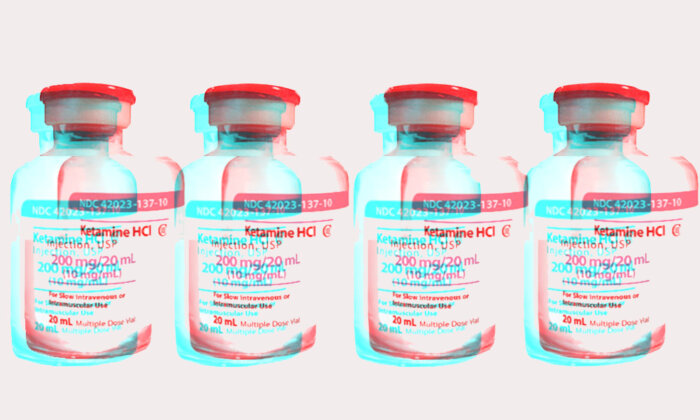The Many Lives of Ketamine

In March of last year, the U.S. Food and Drug Administration approved a quick-acting nasal spray called esketamine for the treatment of depression. Derived from ketamine, esketamine is the first truly novel antidepressant to be introduced to the U.S. market in decades — a remarkable ascent for a relatively new Vietnam-era combat anesthetic and 1980s club drug.

Acting on different brain proteins, and having a more immediate impact than drugs like Prozac, ketamine has the potential to revolutionize our understanding of the neuroscience of depression and how we could treat it more effectively, says Bita Moghaddan, a leading researcher in the field of neuropsychopharmacology and the author of a forthcoming book on the drug. Even if emerging side effects dampen the current push to make ketamine available to patients, there remains excitement about this molecule as a scientific tool that can advance our understanding of depression.
In the following interview with Moghaddam, originally recorded for the MIT Press podcast, we discuss, among other related topics, the history of ketamine and what insights might be gained by examining the popularity of the drug, and the “k-hole” effect, a “profoundly scary and aversive” state of disconnection from your body that comes with taking too high a dose. A stream and lightly edited transcript of the podcast can be found below.
Subscribe to the MIT Press podcast: Apple, Spotify, Podbean
Sam Kelly: In many of the interviews I do with authors I find myself asking about changes that took place in the late 60s and the 70s, the consequences of which we’re still living through now. It’s partly for that reason that I find it fascinating that ketamine’s first widespread use was in the Vietnam War. To begin, could you explain where ketamine was produced and why it was first used in the Vietnam War?
Bita Moghaddam: Sure. Ketamine was synthesized for use as a safe anesthetic. At the time anesthetics were mostly dangerous, especially if you administer them in high doses. Not only were they fatal, they were relatively expensive to use because you needed to be in a surgery room with equipment to monitor heart rate, to make sure the anesthetic didn’t kill the patient. Vietnam was a horrific war and there was a demand for an anesthetic that worked well in combat. Ketamine reduces pain perception and has a minimal effect on the respiratory system.
Prior to ketamine, in the 40s, a drug named phencyclidine (PCP or angel dust) was synthesized; this drug is a hallucinogen that remains in use for recreational purposes. Scientists discovered PCP had a calming effect when it was given to animals, which suggested that it could have an anesthetic property. As a result of this, PCP went to clinical trials for use as an anesthetic. It was relatively safe because higher doses were not fatal, however people came out of PCP anesthesia in a psychotic state. It was therefore never approved for use as an anesthetic but there remained a desire for a drug that produced an immediate and transient anesthetic effect without the danger of fatal overdose; this prompted drug companies to synthesize various analogs of PCP.
The qualities of the drug meant it that it could be used by medics to very quickly put individuals under anesthesia safely without the need for a surgical suite.
This led to the synthesis of ketamine which was found to act like PCP, except it was much shorter acting and lacked the psychotic after effects. Shortly after it was synthesized it went into the market, just as the Vietnam War was raging. The qualities of the drug meant it that it could be used by medics to very quickly put individuals under anesthesia safely without the need for a surgical suite. That’s essentially how it got started and the recreational use followed shortly after. It has gone up and down in terms of where it’s used, how often it’s used, but it very much stemmed from the Vietnam era in terms of popularizing its use as a recreational drug.
SK: You mentioned that there was a drive to synthesize different drugs and specifically different psychoactive drugs. Did this demand come from a military-driven projects?
BM: Oh goodness no. As far as I am aware it was driven by those in medical practice wanting to help patients, and by drug companies motivated by profit. The push to synthesize drugs was driven by pharmaceutical companies in collaboration with academia to understand not only the symptoms of brain disorders but also try and treat them better.
Let’s not forget that psychiatric and neurological disorders such as depression, anxiety, bipolar disorders, and schizophrenia are some of the most devastating and prevalent illnesses facing individuals. These are real illnesses and the drive to find solutions to these disorders are very much the same as the search into treatments for cancer or to produce vaccines to deal with viruses.
It wasn’t about a cure but treating symptoms. In medicine it is important to remember that the only thing that can really be cured is a bacterial infection. Everything else, we either stop the progression or treat the symptoms. Opiates, nicotine, or hallucinogens have been in use for thousands of years, not simply because people wanted to have fun, but because they helped treat symptoms of depression or melancholy.
SK: I want to return to the question of how we frame mental illness later in the interview but before I do that, I wondered if you could explain how the drug went from a medical or military technology to a popular recreational drug?
BM: Frankly, I’m not sure what the steps were. I don’t think anybody knows, except that people try different drugs that they can get access to. I don’t think that it is as widely popular as stimulants or opiates. However, the relative ease with which ketamine can be synthesized may have contributed to its popularity.
It is used extensively in Asian countries and there’s a fair amount of anecdotal evidence for why it’s used. For example, in some Asian countries, it’s popular among college kids or high school kids because they can experience a high during a short break because the effect lasts for 10, 15 minutes or less. Whereas other drugs you’re not going to get away with a quick high experience during your lunch break. That could be one of the reasons, but honestly, I don’t know why people are driven to using a drug like ketamine over amphetamines or alcohol. A lot of times it’s due to availability.
SK: Running parallel to recreational use people continue to study the qualities of this drug and recently there’s been a lot of discussions about its potential as an anti-depressant, can you explain how that has come about?
BM: It has always been approved for use as an anesthetic by the FDA but ketamine wasn’t researched specifically as an antidepressant until recently. It’s been used commonly as veterinary anesthetic but studies involving humans only began in the 90s. Those studies were initially intended to further understand schizophrenia.
Returning to PCP, scientists in the U.S. and in Canada carried out studies on patients with and without schizophrenia in which they were given PCP. It became apparent that PCP profoundly exacerbated symptoms of schizophrenia, as well as producing transient schizophrenia in otherwise healthy people for a day or two. There aren’t many good ways of treating schizophrenia so there are a number of researchers who are interested in understanding the illness so as to develop treatments.
“The effect of ketamine on depression came as the result of scientists trying to model schizophrenia.”
Following on from this, in the early 90s a group of investigators, which included my colleagues at Yale, started giving ketamine to healthy individuals to produce transient symptoms of schizophrenia with the idea that they could then study these individuals. Because ketamine mimics the symptoms of schizophrenia we can study their brain activity to gain a better understanding of the condition.
That’s how ketamine came back to the laboratory, not as an anti-depressant, but as part of well-controlled studies to understand symptoms of schizophrenia better. Those studies were pretty useful and animal studies also provided a fair amount of interesting mechanistic studies.
It was that body of research that gave rise to questions regarding the long-lasting changes in mood caused by the drug. A few years later there was a very small study in which individuals who were suffering from depression were given doses of ketamine. So, to summarize, the effect of ketamine on depression came as the result of scientists trying to model schizophrenia.
SK: Is there a theory as to why taking low doses of ketamine makes you less depressed? Is it simply a result of the person being able to relax and experience some kind of catharsis?
BM: Nothing about the brain is simple and there are a large number of theories. Quite honestly, theories are cheap. We can sit here and theorize all day, but the nice thing about the current state of affairs is that we can actually go into the laboratory and collect data. With that in mind, we don’t know exactly how it works but there are suggestions that something changes with regard to memory systems.
There are different theories and none of them explain exactly why ketamine is doing what it is doing, but I’m hopeful that as these studies progress, we will get a better sense of how it works. Interestingly, it works very much like electric shock therapy. ECT continues to work well on individuals who have treatment-resistant depression and with ECT you only need one treatment to relieve symptoms of depression for many weeks, if not months.
“Nothing about the brain is simple and there are a large number of theories. Quite honestly, theories are cheap.”
These are patients who do not respond to Prozac and other modes of therapy. The depression of individuals who respond to a drug like Prozac (at least a third to half of the population) may be entirely different to the kind of depression where ECT or ketamine would be used.
SK: I’m surprised that you mentioned electroshock therapy in the book, it seems like a practice that has been widely criticized. Sylvia Plath’s “The Bell Jar” comes to mind. I didn’t realize it was still practiced?
BM: It is critical to underscore the fact that the way it’s administered now, is not the way it was done in the last century. It’s far more controlled and humane.
The individuals who are undergoing ECT are those who have not responded to any other treatments. They are anesthetized when they experience this and there is a large amount of research that has gone into optimizing the pattern of current that’s supplied to the brain. It’s very different to what you hear about in the fifties and sixties. It’s used for people who are severely depressed and have tried to take their lives and it’s being used because it’s saving lives.
SK: I’d like to ask you about what might be considered a radical or anti-psychiatry critique of the medicalized frame for mental illness. The argument is that as much as mental illness is constituted biologically, it’s also constituted politically and socially. Say, for example, you’re someone who has a child, you’re working in a supermarket below living wage on a precarious contract and you have to work extra shifts as a cleaner just to get through the month. That would lead most people to feeling depressed and anxious. Thus, these issues are not simply medical but should be re-politicized and subsequently, treating people with antidepressants normalizes the circumstances for this kind of exploitation to continue. As someone who’s done a great deal of research into this area, I’d be interested to hear what you think about that conversation and where you stand on those issues.
BM: I stand on those issues in the same place I stand on cancer, heart disease and diabetes. If you’re poor, if you don’t have access to good food, if you have to work so hard that you have no time to exercise your chances of having heart disease, having cancer, being a diabetic is much higher.
We don’t treat those illnesses differently. If you are diabetic, you need to see if a change in lifestyle can actually treat that. Nobody would argue with that. If you are severely depressed and your GP, your physician, tells you, “Try and go out for walks, try and get more sleep and see if that helps.” Changing your lifestyle in both cases could influence the outcome of the illness. But if you have no choice, if all you can afford to eat is cheap food and you don’t have the kind of job that allows you to go outside and walk. Should you just sit there and be depressed or die of diabetes because you’re denied medication? I hope that people treat brain illnesses like we treat other illnesses.
There is a huge environmental factor in all of them. Very few illnesses are purely genetic. Environment plays a great role in all of these and so the same applies to anxiety, depression that applies to cancer and heart disease. Depression is not an imaginary disease and whilst you can you deal with some of the symptoms by changes of lifestyle, we need to be cautious of the fact that there are times that medication can help people.
SK: Thank you for reflecting on that. Changing tack slightly, I wondered if you could explain a K-Hole. What’s happening to the body when someone is going through that?
BM: I have to give a disclaimer that I have never taken ketamine so this is not based on personal experience. It’s only based on what I have read or what I have been told, but k-hole is a state that occurs when someone takes higher doses of ketamine, that are not quite anesthetic. Whilst lower than anesthetic dose the dose is higher than what individuals may take for a more pleasant dissociative high.
“You essentially feel completely dissociated from the world around you as if you don’t exist in [it].”
This higher dose induces a state where your awareness of the world around you and your control over your own body becomes very impaired. You essentially feel completely dissociated from the world around you as if you don’t exist in this world. The slang refers to how profoundly scary and aversive the experience can be.
SK: Could I push you for a layman’s explanation of what’s happening on a neuroscientific scale?
BM: Essentially, ketamine blocks a protein or a receptor in the brain that is responsible for how many of your nerve cells or neurons interact. A lot of the nerve cells that go from your brain all the way to your spinal cord use this neurotransmitter to communicate. Ketamine blocks that neurotransmitter. At low doses, it’s just a mild dissociation, but at high doses, it could be quite profound. Essentially your brain is dissociating from the information it gets from the outside. For example, I see a tree right now because my visual system is communicating to my brain that this is a tree. High doses of ketamine could block all of that transmission and radically alter my perception of the exterior world.
This also contributes to why ketamine can be fatal. People who are on ketamine can fail to register dangerous stimuli. They might not appreciate how cold they are and freeze, or drowned in their bathtub because the usual autonomic systems essentially shut down. You may not even sense that you are suffocating.
SK: The final question I’m going to ask you is, throughout the entire course of writing a book about ketamine, were you ever curious to try it?
BM: Ha! No. If I’m given the chance to take it in a clinical trial I would, yes. But I am a very strange person, I prefer doing outdoor things or being a scientist who needs to get grants and papers for a living. That’s how I take my risks. Dangerous hikes rather than trying new drugs.
I’m not opposed to taking it for a clinical trial, but it’s not the sort of thing that I would go and seek out. Although, I think other drugs that are being used to treat anxiety and depression such as psilocybin sound far more interesting than ketamine.
SK: Okay. Well, thank you for answering that, and thank you for speaking to me today. I really appreciate you sharing the time with me.
BM: Sure. My pleasure. Thanks for doing this.
Sam Kelly is the host of the MIT Press podcast and a member of the Press’s publicity and marketing team.
Bita Moghaddam is a leading researcher in the field of neuropsychopharmacology. She is Ruth Matarazzo Professor of Behavioral Neuroscience at Oregon Health and Science University in Portland, and the author of “Ketamine.”



